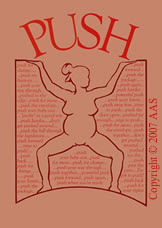Some women may prefer to have an induction, even without medical need. Inducing labor may appeal to both the woman and the health care provider because it helps them plan their schedules. The March of Dimes recommends that labor be induced only when the health of the woman or baby is at risk.
In 2003, labor was induced in 1 out of 5 deliveries in the United States. The rate has more than doubled since 1990. Some health care providers believe that many inductions are medically unnecessary.
--- March of Dimes
http://www.marchofdimes.com/pnhec/240_20202.asp
Statistics for 2007 will likely be more higher than in 2003. I am against induction for many reasons --- 1) induction disrupts the baby's physiological need to begin labor as baby is known to send hormonal message to mother's body to begin labor; 2) induction requires epidural anesthesia for the mother's pain because induced contractions are "horrific" while natural is usually manageable; 3) baby gets the narcotic drugs as well; 4) there is no rest for the uterus or the baby and baby is forced through the birth canal and process; and 5) this creates a dynamic in the personality of the baby and in his or her relationship with the mother; and 6) induction is attributed to increased cesarean rate; and 7) Induction is also connected to the increasing prematurity rate.
I have been on a tear about the use of narcotics during birth and these drugs not being show safe for the birthing baby BEFORE using them and now promoting them as safe. I am thinking about prematurity and wondering about the science that tells us how long a baby ought to gestate. I don't know. I am going to be researching this. All I know is my own personal experience and watching a lot of babies over the past thirty years, but very closely for the past eight.
What is going on? Thirty years ago no baby was born before forty weeks unless it was initiated by the baby or clearly medically necessary. My older daughter was "due" on November 13th and born on November 30th. Seventeen days late and she weighed 7#7oz, the smallest of my four babies. No sign of post-maturity. In recent years I have thanked God, Jesus, and Mother Mary for not having to deal with the medical environment that women do today. My daughter mostly likely would have been born five weeks prior and would have been premature.
My GI Joe was born on March 21st, Spring Solstice, one day early and weighed 7#15 oz. I had insisted to my old geezer, obstetrician that he would be born early because I had read that the Cosmos never give a parent two Aries children (their special!). My first son was a Aries. Not that I was even into horoscopes, but I liked the idea of not going late again. Isn't that why most women are so susceptible to the suggestions or demands of the physician to induce? We're big, we're tired of it. We are tired of people saying we're big and, "Haven't you had that baby yet?" (here's your stupid sign) which these days must be even more ridiculously early and the topic of discussion in the days of "OH, maw gawd? You are not inducing?" My first baby was born four days after his "due date" but I had gone in in pre-labor and was not sent home but was "augmented" they call it now, without my knowledge or consent. He weighed 8# exactly. My body grows pretty average size babies consistently.
My younger daughter was due, according to my calculations on January 6th. My cycle was extremely predictable my entire life. Because I was "high risk" at age 37 I had a Triple Screen test and it came back high likelihood of Downs Syndrome. I was sent to a hospital in St. Louis, four hours away for amniocentesis and "genetic counseling." I went kicking and screaming all the way insisting that I did not want an amnio and that learning whether or not the baby had Down Syndrome would make no difference to me. Prior to the amnio they did a sonogram -- first one ever, fourth child, and decided that I was not as far along as I thought so they said my hormones were not sufficient at the time of the test. WHO KNOWS?? if that is the truth, I wonder now. Regardless, they moved her due date to Feb. 3rd. This was not so convenient as we were scheduled to move from MO to Phoenix in mid February. A decision to induce was introduced to me and at that time, in 1994, a physician could not induce without a medical excuse and a family practice doctor could not induce without answering to a committee of some sort. I know this because in my work place there were four of us expecting a baby between January and mid-February - five, if you include the executive director's wife. The one with the latest due date was mad that her doctor, a family practice physician, who could not induce her, so she would be last. Interesting note -- the day I induced my daughter, well, the second day of inducing, one of my co-workers came in to the hospital in labor and our babies were born within an hour of each other. So, anyway, my daughter weighed 7#11oz and was two weeks early or was she two weeks late? I believe my original due date of January 6th was correct and that she likely would have been born within a short time had we not induced her on the 17th. She was born on the 18th. For an induced and epidural birth, it was a "good birth" -- in the nine to 5 time slot (3:18 pm), no need for other interventions (my body knew what to do by number four), and baby was alive and "seemed fine" (although she came out screaming as I had blasted her out). There were ten other people in the room. Anesthesiologist and resident, OB and two residents, two nurses (day nurse stayed), two pediatric students and her father. I wonder why teaching hospitals don't make larger rooms. I was checked by the OB who said I was ready. I was shocked as it was my first birth to feel nothing and be "ready". At that point, I realized everyone in the room was looking at my crotch. It is clear now that my daughter was not ready --- and, it had nothing to do with her needs and her process at that point, from anyone's perspective. I recall a clear moment of needing something -- privacy or time, a moment with my baby and her dad? It was all rolled into fuzzy feeling of not quite ready. It was like I needed a moment of ceremony or ritual or something. But the need to perform and get out of the spot light prevailed. Three pushes and she was here -- mad, and as I know now in pain from being forced from beginning to end.
There is no science to this as doctors play with dates and make observations afterwards -- based on the condition of the baby. "Oops, that one wasn't really due yet." and "Hmm.... maybe this one was due Jan. 6 -- do you think the test and sonogram could have been off?" My body is pretty consistent in building babies. My boys were close to "due date" and weighed within an ounce of each other and more than the girls. My girls -- I think -- went longer but weighed less. In decades, more than a century actually, wouldn't you think that obstetric science would have this stuff down to a, uh hem, a "science"? so we could really know? So every mother and baby would just cook to the right temperature and then pop out a perfect baby? My older daughter had given birth twice. The second one was well over a week past the "due day", a VBAC, and the fist one was breech on his "due date" so he was born by cesararean a few days later. She found it helpful in HERstory that she had been seventeen days "late" so she wasn't worried. Women born by cesarean don't know their body's physiological history. Meanwhile, there is no definitive understanding of any of these based on SCIENCE. It's all cultural -- a representation of technology, physician need, and cultural changes.
My teacher, Castellino, collects old obstetrics text book and some back to the early forties. He says that obstetrics goes in ten year cycles. I guess, just like fashion and other culturally driven fads and ideas. In the fifties women were expected to keep their weight gain under twenty pounds. My mother gained eleven with her first child and he weighed ten pounds. When I birthed my two older children and gained twenty-eight pounds I was on the verge of the big 3-0 and in trouble. The last months were a constant chiding by the nurse and physician and worrying about weight -- the time the baby needs to gain and mother needs to be nourished.
So, I am wondering, where are we in the current cycle? When I gave birth in 1975, 1977, and 1983 inducing prior to forty weeks was not even a consideration. A baby allowed to go over forty weeks is unheard of now, but back then forty-two weeks was considered safe and normal. I was born two weeks late -- and see how normal I am!? Fourteen years ago we were stretching the rules -- thanks to the gallbladder attack in late December that gave medical cause -- to induce at 37 weeks. NOW, 37 weeks to 40 is also considered full-term. WHO decides this and what research is it based on?
SGA babies may appear physically and neurologically mature but are smaller than other babies of the same gestational age. SGA babies may be proportionately small (equally small all over) or they may be of normal length and size but have lower weight and body mass. SGA babies may be premature (born before 37 weeks of pregnancy), full term (37 to 41 weeks), or post term (after 42 weeks of pregnancy).
http://www.harvardvanguard.org/info/content.asp?pageID=P02411
Even March of Dimes says 37-40 weeks is full-term. I suspect they are being conservative and politically correct. I need to see the research and scientific studies to see why it is that this has changed over the last twenty years.
The Other Side of the Glass
Part One was officially released June 2013 in digital distribution format.
To purchase to to www.theothersideoftheglass.com
If you were a donor and want to download your copy send an email to theothersideoftheglassfilm@gmail.com.
The trailer
Wednesday, March 14, 2007
Subscribe to:
Post Comments (Atom)
"Soft is the heart of a child. Do not harden it."
A public awareness reminder that things that happen behind the scenes, out of our sight, aren't always as rosy as we might think them to be. Perhaps its a restaurant cook who accidentally drops your burger
on the floor before placing it on the bun and serving it to you. Here it's an overworked apathetic (pathetic) nurse giving my newborn daughter her first bath.
Please comment and rate this video, so as to insure that it is viewed as widely as possible, perhaps to prevent other such abuse. -- The mother who posted this YouTube. How NOT to wash a baby on YouTube
Are you going to try to tell me that "babies don't remember?" There is no difference to this baby's experience and the imprinting of her nervous system/brain and one that is held and cleaned by the mother or father either at the hospital or at home?
By the way, this is probably NOT the baby's first bath. The nurse is ungloved. Medical staff protocol is that they can't handle a baby ungloved until is has been bathed (scrubbed if you've seen it) because the baby is a BIO-HAZARD -- for them. Never mind that the bio-hazard IS the baby's first line of defense against hospital germs.
Missouri Senator Louden Speaks
Finally, A Birth Film for Fathers
Part One of the "The Other Side of the Glass: Finally, A Birth Film for and about Men" was released June, 2013.
Through presentation of the current research and stories of fathers, the routine use of interventions are questioned. How we protect and support the physiological need of the human newborn attachment sequence is the foundation for creating safe birth wherever birth happens.
Based on knowing that babies are sentient beings and the experience of birth is remembered in the body, mind, and soul, fathers are asked to research for themselves what is best for their partner and baby and to prepare to protect their baby.
The film is designed for midwives, doulas, and couples, particularly fathers to work with their caregivers. Doctors and nurses in the medical environment are asked to "be kind" to the laboring, birthing baby, and newborn. They are called to be accountable for doing what science has been so clear about for decades. The mother-baby relationship is core for life. Doctors and nurses and hospital caregivers and administrators are asked to create protocols that protect the mother-baby relationship.
Men are asked to join together to address the vagaries of the medical system that harm their partner, baby and self in the process of the most defining moments of their lives. Men are asked to begin to challenge the system BEFORE they even conceive babies as there is no way to be assured of being able to protect his loved ones once they are in the medical machine, the war zone, on the conveyor belt -- some of the ways that men describe their journey into fatherhood in the medicine culture.
Donors can email theothersideoftheglassfilm@gmail.com to get a digital copy.
Through presentation of the current research and stories of fathers, the routine use of interventions are questioned. How we protect and support the physiological need of the human newborn attachment sequence is the foundation for creating safe birth wherever birth happens.
Based on knowing that babies are sentient beings and the experience of birth is remembered in the body, mind, and soul, fathers are asked to research for themselves what is best for their partner and baby and to prepare to protect their baby.
The film is designed for midwives, doulas, and couples, particularly fathers to work with their caregivers. Doctors and nurses in the medical environment are asked to "be kind" to the laboring, birthing baby, and newborn. They are called to be accountable for doing what science has been so clear about for decades. The mother-baby relationship is core for life. Doctors and nurses and hospital caregivers and administrators are asked to create protocols that protect the mother-baby relationship.
Men are asked to join together to address the vagaries of the medical system that harm their partner, baby and self in the process of the most defining moments of their lives. Men are asked to begin to challenge the system BEFORE they even conceive babies as there is no way to be assured of being able to protect his loved ones once they are in the medical machine, the war zone, on the conveyor belt -- some of the ways that men describe their journey into fatherhood in the medicine culture.
Donors can email theothersideoftheglassfilm@gmail.com to get a digital copy.
Buy the film at www.theothersideoftheglass.com.
The film focuses on the male baby, his journey from the womb to the world and reveals healing and integrating the mother, father, and baby's wounded birth experience. The film is about the restoring of our families, society, and world through birthing loved, protected, and nurtured males (and females, of course). It's about empowering males to support the females to birth humanity safely, lovingly, and consciously.
Finally, a birth film for fathers.
The film focuses on the male baby, his journey from the womb to the world and reveals healing and integrating the mother, father, and baby's wounded birth experience. The film is about the restoring of our families, society, and world through birthing loved, protected, and nurtured males (and females, of course). It's about empowering males to support the females to birth humanity safely, lovingly, and consciously.
Finally, a birth film for fathers.
What People Are Saying About the FIlm
Well, I finally had a chance to check out the trailer and .. wow! It's nice that they're acknowledging the father has more than just cursory rights (of course mom's rights are rarely acknowledged either) and it's great that they're bringing out the impact of the experience on the newborn, but I'm really impressed that they're not shying away from the political side.
They are rightly calling what happens in every American maternity unit, every day, by its rightful name - abuse. Abuse of the newborn, abuse of the parents and their rights, abuse of the supposedly sacrosanct ethical principal of patient autonomy and the medico-legal doctrine of informed consent, which has been long ago discarded in all but name. I love it!
In the immortal words of the "shrub", "bring it on!" This film needs to be shown and if I can help facilitate or promote it, let me know.
Father in Asheville, NC
Thanks for sharing this. It was very touching to me. I thought of my brother-in-law standing on the other side of the glass when my sister had to have a C-section with her first child because the doctor was missing his golf date. I'll never forget his pacing back and forth and my realizing that he was already a father, even though he hadn't been allowed to be with his son yet.
Margaret, Columbia, MO
They are rightly calling what happens in every American maternity unit, every day, by its rightful name - abuse. Abuse of the newborn, abuse of the parents and their rights, abuse of the supposedly sacrosanct ethical principal of patient autonomy and the medico-legal doctrine of informed consent, which has been long ago discarded in all but name. I love it!
In the immortal words of the "shrub", "bring it on!" This film needs to be shown and if I can help facilitate or promote it, let me know.
Father in Asheville, NC
OMG'ess, I just saw the trailer and am in tears. This is so needed. I watch over and over and over as fathers get swallowed in the fear of hospitals birth practice. I need a tool like this to help fathers see how very vital it is for them to protect their partner and baby. I am torn apart every time I see a father stand back and chew his knuckle while his wife is essentially assaulted or his baby is left to lie there screaming.
Please send me more info!!!!
Carrie Hankins
CD(DONA), CCCE, Aspiring Midwife
720-936-3609
Thanks for sharing this. It was very touching to me. I thought of my brother-in-law standing on the other side of the glass when my sister had to have a C-section with her first child because the doctor was missing his golf date. I'll never forget his pacing back and forth and my realizing that he was already a father, even though he hadn't been allowed to be with his son yet.
Margaret, Columbia, MO
In case you don't find me here
Soon, I'll be back to heavy-duty editing and it will be quiet here again. I keep thinking this blog is winding down, and then it revives. It is so important to me.
I wish I'd kept a blog of my journey with this film this past 10 months. It's been amazing.
I have a new blog address for the film, and will keep a journal of simple reporting of the journey for the rest of the film.
www.theothersideoftheglassthefilm.blogspot.com
I'll be heading east this week to meet with a group of men. I plan to post pictures and clips on the film blog.
I'll keep up here when I can -- when I learn something juicy, outrageous, or inspiring related to making birth safer for the birthing baby.
I wish I'd kept a blog of my journey with this film this past 10 months. It's been amazing.
I have a new blog address for the film, and will keep a journal of simple reporting of the journey for the rest of the film.
www.theothersideoftheglassthefilm.blogspot.com
I'll be heading east this week to meet with a group of men. I plan to post pictures and clips on the film blog.
I'll keep up here when I can -- when I learn something juicy, outrageous, or inspiring related to making birth safer for the birthing baby.
Review of the film
Most of us were born surrounded by people who had no clue about how aware and feeling we were. This trailer triggers a lot of emotions for people if they have not considered the baby's needs and were not considered as a baby. Most of us born in the US were not. The final film will include detailed and profound information about the science-based, cutting-edge therapies for healing birth trauma.
The full film will have the interviews of a wider spectrum of professionals and fathers, and will include a third birth, at home, where the caregivers do a necessary intervention, suctioning, while being conscious of the baby.
The final version will feature OBs, RNs, CNMs, LM, CPM, Doulas, childbirth educators, pre and perinatal psychologists and trauma healing therapists, physiologists, neurologists, speech therapists and lots and lots of fathers -- will hopefully be done in early 2009.
The final version will include the science needed to advocated for delayed cord clamping, and the science that shows when a baby needs to be suctioned and addresses other interventions. Experts in conscious parenting will teach how to be present with a sentient newborn in a conscious, gentle way -- especially when administering life-saving techniques.
The goal is to keep the baby in the mother's arms so that the baby gets all of his or her placental blood and to avoid unnecessary, violating, and abusive touch and interactions. When we do that, whether at home or hospital, with doctor or midwife, the birth is safe for the father. The "trick" for birthing men and women is how to make it happen in the hospital.
The full film will have the interviews of a wider spectrum of professionals and fathers, and will include a third birth, at home, where the caregivers do a necessary intervention, suctioning, while being conscious of the baby.
The final version will feature OBs, RNs, CNMs, LM, CPM, Doulas, childbirth educators, pre and perinatal psychologists and trauma healing therapists, physiologists, neurologists, speech therapists and lots and lots of fathers -- will hopefully be done in early 2009.
The final version will include the science needed to advocated for delayed cord clamping, and the science that shows when a baby needs to be suctioned and addresses other interventions. Experts in conscious parenting will teach how to be present with a sentient newborn in a conscious, gentle way -- especially when administering life-saving techniques.
The goal is to keep the baby in the mother's arms so that the baby gets all of his or her placental blood and to avoid unnecessary, violating, and abusive touch and interactions. When we do that, whether at home or hospital, with doctor or midwife, the birth is safe for the father. The "trick" for birthing men and women is how to make it happen in the hospital.








No comments:
Post a Comment